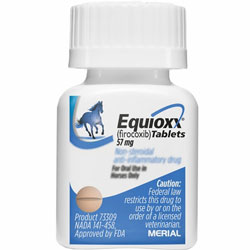Equioxx Tablets
Low Price Match Guarantee
Free Shipping on orders over $75
- Only FDA approved NSAID for horses
- Firocoxib
- An alternative for horses with joint pain
Description
EQUIOXX is a non-steroidal anti-inflammatory drug (NSAID), that is:
- Proven to relieve the pain and inflammation of equine OA.
- Prove in both field and laboratory trials to be safe at the recommended dose.
- Easily administered, once-a-day tablet that is well-accepted by 98% of horses.
- 24 hours of targeted pain relief.
Dosage and Administration
Caution:
Federal law restricts this drug to use by or on the order of a licensed veterinarian.
Contraindications
Horses with a hypersensitivity to firocoxib should not receive Equioxx Tablets.
Warnings
Not for use in humans. Keep this and all medications out of the reach of children. Consult a physician in case of accidental ingestion by humans. For use in horses only. Do not use in horses intended for human consumption.
Precautions
Horses should undergo a thorough history and physical examination before initiation of NSAID therapy. Appropriate laboratory tests should be conducted to establish hematological and serum biochemical baseline data before and periodically during administration of any NSAID. Clients should be advised to observe for signs of potential drug toxicity and be given a Client Information Sheet with each prescription. See Information for Owner or Person Treating Horse section of this package insert.
Treatment with Equioxx should be terminated if signs such as inappetence, colic, abnormal feces, or lethargy are observed. As a class, cyclooxygenase inhibitory NSAIDs may be associated with gastrointestinal, renal, and hepatic toxicity. Sensitivity to drug-associated adverse events varies with the individual patient. Horses that have experienced adverse reactions from one NSAID may experience adverse reactions from another NSAID. Patients at greatest risk for adverse events are those that are dehydrated, on diuretic therapy, or those with existing renal, cardiovascular, and/or hepatic dysfunction. Concurrent administration of potentially nephrotoxic drugs should be carefully approached or avoided. NSAIDs may inhibit the prostaglandins that maintain normal homeostatic function. Such anti-prostaglandin effects may result in clinically significant disease in patients with underlying or pre-existing disease that has not been previously diagnosed. Since many NSAIDs possess the potential to produce gastrointestinal ulcerations and/or gastrointestinal perforation, concomitant use of Equioxx Tablets with other anti-inflammatory drugs, such as NSAIDs or corticosteroids, should be avoided. The concomitant use of protein bound drugs with Equioxx Tablets has not been studied in horses. The influence of concomitant drugs that may inhibit the metabolism of Equioxx Tablets has not been evaluated. Drug compatibility should be monitored in patients requiring adjunctive therapy. The safe use of Equioxx Tablets in horses less than one year in age, horses used for breeding, or in pregnant or lactating mares has not been evaluated. Consider appropriate washout times when switching from one NSAID to another NSAID or corticosteroid.
Information for Owner or Person Treating Horse
A Client Information Sheet should be provided to the person treating the horse. Treatment administrators and caretakers should be aware of the potential for adverse reactions and the clinical signs associated with NSAID intolerance. Adverse reactions may include erosions and ulcers of the gums, tongue, lips and face, weight loss, colic, diarrhea, or icterus. Serious adverse reactions associated with this drug class can occur without warning and, in some situations, result in death. Clients should be advised to discontinue NSAID therapy and contact their veterinarian immediately if any of these signs of intolerance are observed. The majority of patients with drug-related adverse reactions recover when the signs are recognized, drug administration is stopped, and veterinary care is initiated.
Effectiveness
The effectiveness of Equioxx Tablets is based on the results of a two period cross-over study to demonstrate comparable systemic drug exposure between the firocoxib tablet administered at a fixed dose of 57 mg of firocoxib per horse and Equioxx Oral Paste (NADA 141-253) administered at the same fixed dose of 57 mg per horse. The mean concentration-time profiles for both formulations were parallel and nearly superimposable after the time to peak concentration (Tmax) of firocoxib in the blood. This study demonstrated comparative relative bioavailability between the two formulations therefore establishing the same relative effectiveness of the tablet formulation as the paste formulation in horses.
With the establishment of comparable relative bioavailability, the field studies conducted with Equioxx Oral Paste are therefore applicable in establishing the effectiveness of the tablet formulation as well. Two hundred fifty-three client-owned horses of various breeds, ranging in age from 2 to 37 years and weighing from 595 to 1638 lbs, were randomly administered Equioxx Oral Paste or an active control drug in multi-center field studies. Two hundred forty horses were evaluated for effectiveness and 252 horses were evaluated for safety. Horses were assessed for lameness, pain on manipulation, range of motion, joint swelling, and overall clinical improvement in a non-inferiority evaluation of Equioxx Oral Paste compared to an active control. At study’s end, 84.4% of horses treated with Equioxx Oral Paste were judged improved on veterinarians’ clinical assessment, and 73.8% were also rated improved by owners. Horses treated with Equioxx Oral Paste showed improvement in veterinarian-assessed lameness, pain on manipulation, range of motion, and joint swelling that was comparable to the active control.
Animal Safety
The safety of firocoxib tablets is inferred based on demonstrated comparable relative bioavailability to the oral paste formulation. Relative bioavailability of the two formulations was determined based on the analysis of plasma drug concentration in 30 horses at specific intervals during a two period crossover study with firocoxib oral paste and a firocoxib tablet. The safety profile is expected to be similar, since the pharmacodynamic profile of the two firocoxib formulations are comparable. The safety of firocoxib in horses was demonstrated in target animal safety studies and field studies conducted for the registration of the oral paste and injectable equine products. Low incidence of adverse reactions have been reported within field safety reports collected since the approval of Equioxx Oral Paste and Equioxx Injection for horses.
In a target animal safety study conducted to support the approval of Equioxx Oral Paste (NADA 141-253), firocoxib was administered orally to healthy adult horses (two male castrates and four females per group) at 0, 0.1, 0.3 and 0.5 mg firocoxib/kg body weight (1, 3 and 5X the recommended dose) for 30 days. Administration of firocoxib at 0.3 and 0.5 mg/kg body weight was associated with an increased incidence of oral ulcers as compared to the control group, but no oral ulcers were noted with 0.1 mg/kg. There were no other drug-related adverse findings in this study. In another target animal safety study, firocoxib was administered orally to healthy adult horses (four males or male castrates and four females per group) at 0, 0.1, 0.3 and 0.5 mg firocoxib/kg body weight (1, 3 and 5X the recommended dose) for 42 days. Administration of firocoxib at 0.1, 0.3 and 0.5 mg/kg body weight was associated with delayed healing of pre-existing oral (lip, tongue, gingival) ulcers. In addition, the incidence of oral ulcers was higher in all treated groups as compared to the control group. Clinical chemistry and coagulation abnormalities were seen in several horses in the 0.5 mg/kg (5X) group. One 5X male horse developed a mildly elevated BUN and creatinine over the course of the study, prolonged buccal mucosal bleeding time (BMBT), and a dilated pelvis of the right kidney. Another 5X male had a similar mild increase in creatinine during the study but did not have any gross abnormal findings. One female in the 5X group had a prolonged BMBT, bilateral tubulointerstitial nephropathy and bilateral papillary necrosis. Tubulointerstitial nephropathy occurred in one 3X female, two 3X male horses, and the 5X female horse discussed above with the prolonged BMBT. Papillary necrosis was present in one 1X male horse and the 5X female horse discussed above. Despite the gross and microscopic renal lesions, all of the horses were clinically healthy and had normal hematology, clinical chemistry and urinalysis values.
In another target animal safety study, firocoxib was administered orally to healthy adult horses (three females, two male castrates and one male per group) at 0, 0.25 mg/kg, 0.75 mg/kg and 1.25 mg/kg (2.5, 7.5 and 12.5X the recommended dose of 0.1 mg/kg) for 92 days. An additional group of three females, two male castrates and one male per group, was dosed at 1.25 mg/kg for 92 days but was monitored until Days 147-149. There were treatment-related adverse events in all treated groups. These consisted of ulcers of the lips, gingiva and tongue and erosions of the skin of the mandible and head. Gross and microscopic lesions of the kidneys consistent with tubulointerstitial nephropathy were seen in all treated groups. Papillary necrosis was seen in the 2.5X and 12.5X groups. In addition, several 12.5X horses had elevated liver enzymes (GGT, SDH, AST and ALT). One 2.5X horse had increased urine GGT and urine protein levels which was due to renal hemorrhage and nephropathy. Gastric ulcers of the margo plicatus and glandular area were more prevalent in the 2.5X and 7.5X groups, but not seen in the 12.5X group. The group of horses that were monitored until Days 147-149 showed partial to full recovery from oral and skin ulcers, but no recovery from tubulointerstitial nephropathy.
A target animal safety study was conducted to assess the safety of Equioxx Injection followed by Equioxx Oral Paste in the horse. Thirty-two clinically healthy adult horses received Equioxx Injection intravenously once daily for five days at doses of either 0 mg/kg (control group); 0.09 mg/kg (1X); 0.27 mg/kg (3X); or 0.45 mg/kg (5X the recommended dose). This was followed by once daily oral administration of Equioxx Oral Paste for nine days at doses of either 0 mg/kg (control group); 0.1 mg/kg (1X); 0.3 mg/kg (3X); or 0.5 mg/kg (5X the recommended dose). This sequence (five days of Equioxx Injection followed by nine days Equioxx Oral Paste, for a total of 14 days) was repeated three times for a total treatment duration of 42 days (3X the recommended treatment duration of 14 days). Two male 5X horses demonstrated a white focus in the renal cortex which correlated with tubulointerstitial nephropathy microscopically. The presence of tubulointerstitial nephropathy was considered treatment-related. One horse from the control group and two horses from the 5X group had injection site swellings during treatment. Injection site changes characterized by inflammatory cell influx and rarely tissue necrosis were seen in all study groups including the control group. There was a dose-dependent increase in the incidence of oral ulcers and erosions. Elevated hepatic enzymes (GGT or AST) were noted in all study groups at one or more time points. One male 5X horse with an elevated GGT value on Day 42 was noted to have tubulointerstitial nephropathy at the time of necropsy. For all horses, these hepatic enzyme elevations generally returned to the reference range by the next time point.
Storage
Store at room temperature, between 59°- 86 °F (15° - 30°C). Brief periods up to 104°F (40°C) are permitted.






